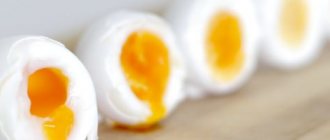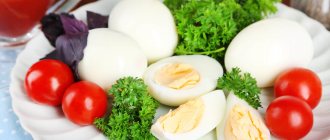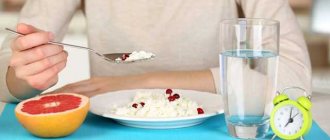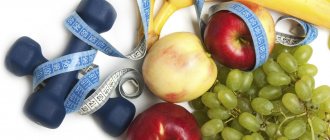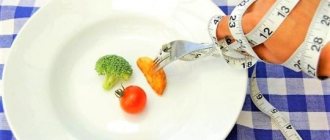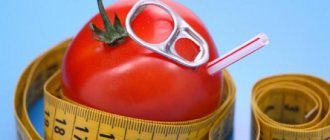During illness, in addition to medications, a correct diet and a certain diet play an important role in maintaining strength and restoring the body. Therapeutic diets help
a speedy recovery, replenishing the lack of nutrients and vitamins, as well as preventing the disease from becoming chronic. For some diseases, a balanced menu is almost the only method of treatment (for example, obesity). The technology of food processing, the temperature regime of the food consumed, portion sizes, frequency and time of meals are very important.
Exacerbations of many chronic diseases are closely related to all kinds of nutritional disorders: changes in diet for diabetes lead to a sharp increase in blood sugar, dry mouth and increased thirst. In chronic pancreatitis, after eating fatty and fried foods, fatty infiltration of the liver and pancreas begins to progress. When eating salty foods, patients suffering from hypertension experience an increase in blood pressure. Therefore, an individual set of products is selected for each patient in accordance with metabolic, functional and other changes in the internal organs. As you apply the recommended diet, it can be gradually adjusted. Nutritionists take into account not only the current diagnosis, the form and stage of the disease, the patient’s body weight, but also the likelihood of allergic reactions.
Principles of therapeutic nutrition
The principles of proper and rational nutrition are completeness, variety, moderation. The diet must satisfy a person’s daily need for nutrients in the proportions required by the body. It is very important to take into account the energy value of the dishes offered. Energy consumption to maintain metabolic processes and physical effort must be compensated by the composition of permitted products. In sanatorium-resort and medical institutions they use a numbered diet system. Many treatment tables have several options, for example: N 7a, 76, 7b, 7d. Each table is designed to prevent and treat a specific disease, and in the case of several diseases, the doctor may prescribe a combination of two or more diets.
Organization of dietary meals includes:
- selection of high-quality food composition (increasing or decreasing the amount of proteins, fats and carbohydrates).
- selection of the nature of culinary processing (stewing, baking, boiling and other methods).
- determination of the regime (volume of portions and meal times).
The basis of all therapeutic diets
– complete exclusion of alcohol, fried, fatty, spicy and pickled foods, as well as large amounts of sugar and caffeine. Cooking methods: steamed, stewed or boiled. Dietary dishes may have a specific appearance, so it is advisable to serve them with a combined side dish of different vegetables, garnished with parsley and dill. It is very important to eat regularly at the same hours, since in this case gastric juice is actively produced at the set time, promoting better digestion. During the period of recovery and return to an active lifestyle, it is advisable not to change the general principles of the diet. You can add other methods of preparing dishes, without giving up home-canned vegetables and fruits. The question of the possibility of consuming previously prohibited products is decided only by the attending physician.
Menu for table No. 4
Menu for table No. 4
| Eating | List of dishes |
| For breakfast | Liquid semolina porridge, pureed oatmeal, low-fat cottage cheese, grated apples, cocoa, baked pears or apples, green tea |
| For lunches | Broth with semolina, vegetable broth and pureed buckwheat, rice soup with meatballs, weak fish broth with herbs and rice, wheat crackers |
| For dinners | Mashed porridges from permitted grains, steamed cutlets, stewed fish and meatballs, semolina soufflé, meat puddings, baked fish (without skin) |
| For snacks | Homemade jelly, jellies, rosehip infusions, wheat crackers, berry and fruit infusions (without sugar), cocoa in water, baked pears and apples |
It is quite difficult to follow such a strict diet. The duration of the treatment course is determined by the doctor. As a rule, this is a short-term diet, so you will have to endure a little. After you feel better, the doctor prescribes a different diet. Let's look at some recipes that will help diversify your daily menu.
Rice cocoa recipe
To prepare you will need:
- 100 g rice;
- 1.5 liters of water;
- 50 g cocoa;
- a little sugar.
The washed rice should be completely boiled over low heat. Strain the resulting mass through cheesecloth. Grind cocoa with sugar until smooth. Pour cocoa into the rice broth and strain everything again. Serve the resulting drink warm. The recipe is suitable for all diet options and table No. 10.
Meat quenelles recipe
To prepare you will need:
- 100 g cottage cheese;
- 200 g beef (fillet without tendons and fascia);
- 1 chicken egg;
- 10 g butter.
The beef must be cut and minced twice. Rub the cottage cheese thoroughly through cheesecloth. Mix the minced meat and cottage cheese, add a little salt, beat in the egg, then add soft butter. Mix everything well and form quenelles. Steam for 20 minutes. The recipe is suitable for tables: 4, 4a, 4b, 4c.
Medical treatment tables. Purpose.
In sanatorium-resort and medical institutions they use a numbered diet system. Many treatment tables have several options, for example: N 7a, 76, 7b, 7g. Each table is designed for the prevention and treatment of a specific disease, and in the case of several diseases, the doctor may prescribe a combination of two or more diets. A feature of all medical tables from 1 to 15 is the complete exclusion of alcohol!
Diet No. 1, 1a, 1b
– stomach and duodenal ulcers;
Diet No. 2
– chronic and acute gastritis, colitis, enteritis, chronic enterocolitis;
Diet No. 3
– constipation;
Diet No. 4, 4a, 4b, 4c
– intestinal diseases with diarrhea;
Diet No. 5, 5a
– diseases of the biliary tract and liver;
Diet No. 6
– urolithiasis, gout;
Diet No. 7, 7a, 7b
– chronic and acute nephritis;
Diet No. 8
– obesity;
Diet No. 9
- diabetes;
Diet No. 10
– diseases of the cardiovascular system;
Diet No. 11
– tuberculosis;
Diet No. 12
– diseases of the nervous system;
Diet No. 13
– acute infectious diseases;
Diet No. 14
– kidney disease with the passage of oxalate stones;
Diet No. 15
– diseases that do not require special diets.
Features of the egg-orange diet
Oranges in this diet can be replaced with grapefruits. These fruits are similar in composition, so the result will be just as effective. Eggs are rich in protein, which means that by eating them, the body receives important amino acids and the necessary feeling of fullness. This product can strengthen the immune system and is also good for hair, nails and teeth. Plus it's low in calories.
Sunny fruits are quite often used in diets. We recently described the orange diet with a menu for 7 days. Thanks to citrus fruits, the digestion process improves and the intestines are cleansed. These fruits can cause a feeling of fullness. They are also necessary for removing waste, toxins and providing the body with vitamins. With this diet, you can eat vegetables, but they must be cooked in water. It is recommended to drink as much fluid as possible. It is advisable to drink plain water or tea without sugar.
Caution doesn't hurt
There are some contraindications to using this diet that must be taken into account:
- various kidney and liver diseases;
- diabetes;
- lactation period;
- diseases of the gastrointestinal tract;
- individual food intolerance.
Unfortunately, citrus fruits can cause an allergic reaction. Therefore, if it appears and you feel weak and unwell, then you should stop the diet.
Characteristics and description of therapeutic diets
Table No. 1
Table No. 1 is indicated for gastritis with high acidity, duodenal and gastric ulcers during the period of exacerbation and at the subsiding stage.
Diet:
4-5 times a day in small portions, mostly pureed
Duration:
at least 2 months
It is recommended to consume pureed vegetable soups and porridges, vegetable purees (except cabbage), boiled lean fish and beef, steam cutlets from them, boiled skinless chicken, whole milk, vegetable and butter, as well as cream, fresh sour cream and cottage cheese, soft-boiled eggs , stale white bread, baked apples, sweet fruits, fruit and vegetable juices, puddings, biscuits, jelly, weak tea and coffee. It is necessary to limit the consumption of strong broths and coarse vegetable fiber. Spices, strong coffee, mushrooms, and hard-boiled eggs are completely excluded.
Table No. 1a
Table No. 1a is indicated for a sharp exacerbation of chronic gastritis, gastric and duodenal ulcers in the first week of treatment, a burn of the esophagus, as well as for acute gastritis on days 1-4 of treatment.
Diet:
6-7 times a day in small portions, warm
Duration:
at least 2 months
It is recommended to consume milky and slimy soups from cereals and pureed vegetables, liquid porridges, soft-boiled eggs and steam omelettes, soufflé from lean fish or beef, olive and butter (added to the dish), berry jelly, weak tea, rosehip decoction. It is advisable to limit salt and drink no more than one and a half liters of liquid per day. Vegetable fiber, broths, mushrooms, bread and bakery products, fermented milk products, spices, coffee and cocoa are completely excluded from the daily menu.
Table No. 1b
Table No. 1b is indicated when the manifestations of chronic gastritis and gastric ulcer subside.
Diet:
6 times a day in small portions
Duration:
a few days
It is recommended to consume slimy soups, liquid porridges, soft-boiled eggs, soufflés made from lean fish or beef, olive and butter, berry jelly, cream, fruit juices, weak tea, and rosehip decoction. You can also add steamed fish and meat dishes, pureed milk soups with vegetables, pureed milk porridge, and wheat crackers. Salt consumption should be limited.
Sign up for a consultation on therapeutic diets
Make an appointment
Table No. 2
Table No. 2 is indicated for chronic gastritis with secretory insufficiency, chronic enterocolitis, as well as during the recovery period after surgery or during acute infection.
Diet:
meals 4-5 times a day, boiled, steamed, baked or lightly fried without breading
Duration:
long time
It is recommended to consume soups from cereals and vegetables in weak fish and meat broths, lean beef and chicken (stewed, steamed, baked, in the form of jelly), lean fish (boiled, steamed, jellied), lean lightly salted herring, butter, fresh kefir and sour cottage cheese, light mild cheese, soft-boiled eggs, scrambled eggs, dried white bread, mashed boiled carrots and beets, boiled cauliflower, stewed pumpkin or zucchini, herbs, sauces (meat, fish, sour cream and vegetable broth), weak coffee and tea , rosehip decoction. Excluded from the diet are fresh wheat bread and rich confectionery products, canned food, smoked meats, fatty meats and fish, cucumbers, garlic, bell peppers, legumes, whole milk, carbonated drinks, hot seasonings and spices.
Table No. 3
Table No. 3 is indicated for diseases with frequent constipation during periods of exacerbation or remission.
Diet:
4-5 times a day
Duration:
no limits
It is recommended to consume foods that enhance intestinal motility, as well as wholemeal wheat bread, soups with low-fat broth or vegetable broth, prunes, dried apricots, lean meats and fish, buckwheat and pearl barley porridge, cottage cheese, cheesecakes, fresh kefir, hard-boiled eggs, homemade compotes, juices, mineral water. You can add butter or olive oil to prepared dishes. At night, be sure to drink kefir, eat a few prunes or grated beets. You should not eat cocoa, strong tea, jelly, turnips, radishes, garlic, or mushrooms.
Table No. 4
Table No. 4 is indicated for gastroenterocolitis, chronic and acute enterocolitis, dysentery, and after intestinal surgery.
Diet:
every 5-6 hours in small warm portions
Duration:
no more than 5-7 days
It is recommended to eat stale crackers from white bread, soft-boiled eggs, cottage cheese, semolina and rice porridge in water, butter, boiled meat and fish, three-day kefir, jelly, blueberry and black currant infusion, rosehip infusion, weak coffee and tea. Products that enhance intestinal motility, as well as pickles, smoked foods, and spices are excluded. The amount of salt is limited.
Table No. 4a
Table No. 4a is indicated for chronic colitis with a predominance of fermentation processes.
Diet:
every 5-6 hours in small warm portions
Duration:
a few days
The nutritional composition is the same as in diet Table No. 4, however, it is recommended to sharply limit carbohydrate-rich foods (bread, cereal, sugar) and increase the protein content through meat and cottage cheese dishes.
Table No. 4b
Table No. 4b is indicated for chronic colitis during the period of attenuation of the disease.
Diet:
4-6 times a day, boiled or steamed warm dishes in pureed form or with a slimy consistency
Duration:
1-2 months
The nutritional composition is the same as in the diet Table No. 4, however, it is possible to expand the daily menu with snacks (mild cheese, jellied lean meat or tongue, doctor’s or veal sausage, pate, soaked herring) and sauces based on weak meat and fish broths with the addition of bay leaf, dill, and a small amount of sour cream.
Table No. 4b
Table No. 4c is indicated for chronic and acute intestinal diseases during the recovery period.
Diet:
5 times a day
Duration:
a few months
The nutritional composition is the same as in diet Table No. 4 with the exclusion of foods that enhance fermentation processes in the intestines, limiting salt intake and a slight increase in the amount of protein foods. Dishes should be steamed, baked or boiled. Can also be served crushed.
Table No. 5
Table No. 5 is indicated for acute hepatitis and cholecystitis, chronic hepatitis and cholecystitis, liver cirrhosis, as well as during the recovery period.
Diet:
5-6 times a day in small warm portions
Duration:
long time
It is recommended to consume milk and fruit soups without meat, cereal soups with vegetable broth, boiled fish, poultry and lean meats, cottage cheese, kefir, milk, flour dishes and cereals, white and black stale bread, sweet berries and fruits, herbs and vegetables. , honey, jam, fruit and vegetable juices, weak tea with milk. You should limit your intake of fats and salt. Alcoholic drinks, mushrooms, spinach, sorrel, lemon, spices, cocoa, as well as smoked and fatty foods, and canned food are completely excluded.
Table No. 5a
Table No. 5a is indicated for acute diseases of the liver and biliary tract with concomitant diseases of the stomach, intestines, as well as for acute and chronic pancreatitis in the acute stage.
Diet:
5 times a day
Duration:
a few days
It is recommended to eat slightly dried wheat bread, slimy soups from vegetables and cereals, noodles with vegetable broth, lean meat soufflé, boiled lean fish and steam soufflé made from it, boiled or steamed vegetables, porridge with water or with a small amount of milk, fresh cottage cheese and kefir. Eggs, butter and olive oil can only be added to dishes. For sweets - honey, jelly, jellies, compotes and fruit and berry juices, weak tea. All food should be served mostly pureed. Various snacks, spices, turnips, radishes, sorrel, cabbage, spinach, cocoa are excluded.
Sign up for a consultation on therapeutic diets
Make an appointment
Table No. 6
Table No. 6 is indicated for gout and uric acid diathesis, erythremia.
Diet:
5 times a day
Duration:
long time
It is recommended to consume black and white bread, milk and dairy products, honey, sugar, milk and vegetable soups, cereal products, sweet fruits, fruit juices, jam, cucumbers, lettuce, carrots, lean fish and meat, eggs. Drinking plenty of fluids (up to 2-2.5 liters per day) in the form of weak tea, fruit and berry juices, and mineral waters is also prescribed. Meat and fish soups, kidneys, liver, herring, lard, sardines, sprats, mushrooms, pates, spinach, sorrel, legumes, cocoa and coffee are completely excluded.
Table No. 7
Table No. 7 is indicated for acute glomerulonephritis during the recovery period, chronic nephritis without renal failure, hypertension, and nephropathy in pregnant women.
Diet:
4-5 times a day
Duration:
long time
It is recommended to consume vegetarian soups, lean poultry, meat, fish, gray and white bread with bran, pasta, cereals, flour products, milk and fermented milk products, cottage cheese, vegetables (natural, boiled and baked), herbs, fruits, berries, jam, honey You should limit your consumption of sour cream and cream. Carbonated drinks, creams and cakes, legumes, mushrooms, fish and meat broths, canned food, smoked meats, and pickles are completely excluded.
Table No. 7a
Table No. 7a is indicated for acute and chronic nephritis in the acute stage.
Diet:
5 times a day
Duration:
a few days
The nutritional composition is the same as in the Table No. 7 diet with a strict restriction of liquid (no more than 600-800 ml) and salt. It is recommended to eat boiled vegetables, fruits, flour and cereal products, white bread without salt, tea with milk, butter, sugar. Meals should be fractional. Dishes are steamed or boiled and served pureed.
Table No. 7b
Table No. 7b is indicated during recovery from acute kidney inflammation.
Diet:
5 times a day
Duration:
from several days to several months
This diet is a transition from Table No. 7a to Table No. 7. You can eat white salt-free bread, boiled lean fish and meat, and reduce your salt intake. Meals are fractional. Cooking method: boiling or steaming. Vegetables are served only pureed.
Table No. 8
Table No. 8 is indicated for obesity.
Diet:
5-6 times a day
Duration:
long time
This diet is characterized by a decrease in the energy value of the diet due to carbohydrates and fats, while the protein content remains normal or increases. In addition, salt, appetite-stimulating foods and spices, as well as liquids, are limited.
It is recommended to eat rye bread, meat and vegetable soups with cereals, lean fish, poultry and meat (stewed, baked or boiled), jelly, buckwheat porridge, low-fat cottage cheese and fermented milk products, fruits and berries, juices and compotes from them, vegetables with vegetable oil. You should completely exclude products made from butter dough and premium flour, pasta, legumes, cereal and potato soups, fatty fish, poultry and meat, smoked meats, sausages, canned food, fatty cheese, cream, pasta, oatmeal and semolina, spicy and fatty snacks, mayonnaise, sauces, spices and seasonings.
Table No. 9
Table No. 9 is indicated for mild to moderate diabetes. The diet involves individual selection of daily energy value.
Diet:
5 times a day
Duration:
long time
It is recommended to consume protein-bran, wheat and rye bread, soups with vegetable broth, fish, poultry and lean meats, milk, cheese, low-fat cottage cheese, fermented milk products, cereals (buckwheat, oatmeal, pearl barley, wheat), vegetables and fruits in any quantity. Rich flour products, fatty and strong broths, salted fish, sausages, pickled dishes, semolina and pasta, figs, raisins, bananas, dates are completely excluded. Food is served boiled or baked. Fried foods are limited.
Sign up for a consultation on therapeutic diets
Make an appointment
Table No. 10
Table No. 10 is indicated for diseases of the cardiovascular system without signs of circulatory failure. The diet involves limiting animal fats, cholesterol-containing foods, and table salt.
Diet:
4-5 times a day
Duration:
long time
It is recommended to eat wholemeal bread, crackers, crispbread, savory cookies, vegetarian soups (cereal, milk, fruit), low-fat meat broth, milk, cottage cheese, fermented milk products, poultry, fish and lean meat, protein omelet, vegetables with vegetable oil, oatmeal and buckwheat porridge, puddings, casseroles, fermented milk products, low-fat cheese, fresh cottage cheese, fruits and berries, juices from them, weak coffee and tea. Dishes are served boiled or baked. Products made from butter dough, fresh bread, mushroom and fish broths, legume soups, sausages, smoked meats, kidneys, fatty cheeses, legumes, pickled and salted vegetables, fruits, cocoa, strong coffee and tea, and chocolate are completely excluded.
Table No. 10a
Table No. 10a is indicated for diseases of the cardiovascular system with severe symptoms of circulatory failure. The diet involves a sharp restriction of table salt and liquid, as well as the exclusion from the diet of foods and drinks that stimulate the central nervous system, affecting the activity of the heart and kidneys.
Diet:
4-5 times a day
Duration:
long time
An assortment of dishes similar to Table No. 10 is recommended, but the amount of meat and fish is reduced, vegetables are offered only in boiled and pureed form, and fresh fruits are offered only in pureed form. Food is prepared without salt. Rich soups, spicy and salty dishes, strong tea and coffee, and flour products are completely excluded.
Table No. 11
Table No. 11 is indicated for tuberculosis or general exhaustion of the body. This varied and nutritious diet is characterized by increased energy value with a high content of proteins, minerals and vitamins.
Diet:
4-5 times a day
Duration:
a few months
It is allowed to consume almost all dishes, except for fatty poultry (duck) and meat, as well as cooking, beef and lamb fats, and desserts with a lot of cream.
Table No. 12
Table No. 12 is indicated for people with functional diseases of the nervous system.
Diet:
4-5 times a day
Duration:
a few months
It is recommended to consume all foods except rich broths, hot seasonings, various smoked foods, fried and fatty foods, strong coffee and tea, and alcohol. It is advisable to limit the consumption of salt and meat and more often include tongue, liver, legumes, and dairy products in the menu.
Table No. 13
Table No. 13 is recommended for people with acute infectious diseases. The peculiarities of this diet are that dishes are served mainly in liquid form, without the addition of spices and herbs, as well as milk.
Diet:
up to 8 times a day in small portions
Duration:
a few days
You should eat dried wheat bread, low-fat meat and fish broths, meat soufflé or puree, steamed cutlets and meatballs, fish aspic, mucous cereal decoctions, vegetable-based soups, fresh cottage cheese and products made from it, fermented milk drinks, butter, pureed porridge ( buckwheat, semolina, rice, oatmeal), sweet fruits, fruit and berry juices, jelly, mousses, marmalade, tea with lemon, weak coffee. Fresh bread, rich pastries, fatty fish and meat, smoked meats, sausages, canned food, cheeses, full-fat sour cream and cream, whole milk, pasta, barley and pearl barley, millet, onions, garlic, radishes, white cabbage are completely excluded from the diet. , legumes, cucumbers, cocoa, chocolate, hot sauces, high fiber fruits.
Table No. 14
Table No. 14 is indicated for urolithiasis with phosphate stones and alkaline urine reaction. The diet is a complete diet with a limitation of calcium-rich foods.
Diet:
5 times a day
Duration:
long time
It is recommended to consume bread and confectionery, weak broths and soups, fish and meat, cereals in any form of culinary processing, pumpkin, green peas, sour berries and apples, mushrooms, honey, weak tea and coffee, cranberry or lingonberry fruit drinks. Vegetable and milk soups, salted fish, smoked meats, dairy products, cereals with milk, vegetables (except those permitted by a nutritionist), vegetable salads, and hot sauces should be completely excluded from the diet.
Table No. 15
Table No. 15 is indicated for diseases without the need for therapeutic diets. This is a complete diet with plenty of vitamins, excluding spicy and hard-to-digest foods, as well as limiting canned foods.
Diet:
4-5 times a day
Duration:
no limits
Sign up for a consultation on therapeutic diets
Make an appointment
Egg-orange diet menu for seven days
Diet for five days
This type of diet involves eating one orange and two eggs for breakfast, lunch and dinner. They can be boiled or fried. Between meals, you should drink water and tea without sugar. This diet is not suitable for those with high stomach acidity.
There is also an express diet, designed for only three days. This option is suitable for those who want to lose just a couple of extra pounds before summer or an important special event.
Diet menu for three days
For breakfast you should eat two soft-boiled eggs and half a citrus fruit on all days of the diet. For lunch you can eat a salad of fresh vegetables and two eggs. For dinner you can afford poultry, vegetables and an orange.
While following this diet, you need to drink water, tea without sugar and any fruit juices in any quantity. You can also dilute the diet with fresh herbs, such as parsley.
Important!
You should only drink freshly squeezed orange juice. A ready-made store-bought drink contains a lot of sugar, which is unacceptable when losing weight.
With such a diet, the ability to eat properly, as well as the habit of simple food, is formed. The diet is quite satisfying, despite the low calorie content of the products used. In addition, it has a positive effect on overall health.
The downside of this diet is the lack of carbohydrates and the possibility of an allergic reaction to citrus. Therefore, you should not stick to it for more than four weeks.
In a four-week diet on eggs and oranges you can lose up to 15 kilograms, in a seven-day diet - up to 5 kilograms, in a five-day diet - up to 4 kilograms and in a three-day diet - up to 3 kilograms.
Numerous reviews confirm the effectiveness of the egg-orange diet. Most women who stick to it note quick results.
To avoid gaining weight after losing weight, you need to continue to monitor your diet. You need to leave the diet not immediately, but gradually, making some amendments to your diet in the form of adding new foods. You also need to monitor the calorie content of your food. You can sometimes arrange fasting days.
Where can I sign up for a consultation on therapeutic diets?
At the multidisciplinary medical center you can always sign up for a consultation on therapeutic diets
. Our medical center is located between the Konkovo and Belyaevo metro stations (South-Western Administrative District of Moscow in the area of the Belyaevo, Konkovo, Teply Stan, Chertanovo, Yasenevo, Sevastopolskaya, New Cheryomushki metro stations " and "Trade Union"). Here you will find highly qualified personnel and the most modern diagnostic equipment. Our clients will be pleasantly surprised by our quite affordable prices.
Permitted and prohibited products
What you can and cannot eat during 4 weeks on the egg-orange diet:
| Allowed foods and drinks | Prohibited Products |
|
|
Monday
Throughout the day, any fruit in any quantity, at any time, in combination with any other fruit except: grapes, mangoes, dates, bananas, figs.
Tuesday
Throughout the day, any boiled vegetables and any salads, except in combination with potatoes and dry cereals.
Wednesday
Throughout the day, any fruits listed earlier, any boiled vegetables, salads in any quantity, at any time.
Thursday
Boiled or fried fish in any quantity, salad (only cabbage or lettuce) in any quantity, boiled vegetables.
Friday
Boiled or fried lean meat, except lamb, or chicken, boiled vegetables.
Saturday and Sunday
Throughout the day, one type of fruit in any quantity, at any time (only apples or only pears, or only peaches, or only apricots).
pros
- Effective weight loss in a short time.
- Availability of intended products.
- Specific menu (without calculating the nutritional and energy value of dishes).
- Three meals (easy to combine with study or work).
- The body is cleansed of toxins because you do not consume sugar, alcohol or salt for two weeks.
- Protein is present in sufficient quantities - this prevents muscle loss. In addition, a lot of energy is spent on digesting and assimilating protein, which speeds up metabolism.
Diet options
With green tea For men For vegetarians During pregnancy Rice Banana
Home delivery of products
Rating of Moscow services based on customer reviews. Discounts and promotions.
Go
Go

